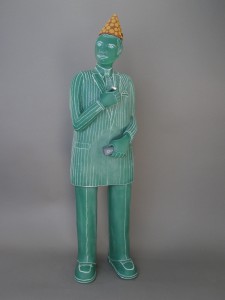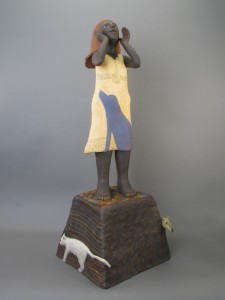
30 Jun Telluride Gallery of Fine Art: McNair’s “Dolls” for Art Walk

“His Own Undoing”
The girl can’t help it. Sculptor and long-time Telluride local Julie McNair was born to make art.
Julie’s mother had studied fine art and music in college. Her grandmother was an antique dealer with a large collection of dolls from Europe and China. Both women were always up to something creative. Julie’s entire family encouraged her in her personal goal to become an artist.
She gathered credentials. Julie studied sculpture at North Texas State University and then earned a master of fine art in sculpture at the University of Wyoming. After graduating, McNair worked as an Artist-in-Residence for Northwest Community College in Powell, Wyoming, where she taught bronze casting and set up a foundry and was then hired as an Assistant Professor at Mississippi State University to teach ceramics, sculpture design and art appreciation. She was director of the Art League of Houston, which involved running all aspects of a non-profit school and gallery.
Julie McNair moved to Telluride in 1985 in search of less stressful work and a more laid back lifestyle. She owned and operated McNair Gallery for more than 17 years, where she represented herself and other emerging artists. She began teaching at the Ah Haa School for the Arts in 1992. In 2006, she accepted a staff position, which she resigned to work full time in her studio.
Julie is currently represented in Telluride by the Telluride Gallery of Fine Art, where a show of her new work opens with a special holiday edition of Telluride Arts‘ Art Walk. The artist’s reception is Tuesday, July 2, 5:30 – 7:30 p.m.
Julie McNair makes doll-like figures – but don’t be thinking of Barbie. Barbie has curves. McNair’s whimsical creations throw you a few.
Dolls have a history dating back 25,000 years. The earliest dolls evolved out of a spiritual context and were used in a wide variety of rituals and ceremonies to heal the sick, make barren women fertile, capture the spirit of an enemy, influence the outcome of love and war. The use of dolls in the voodoo religion is the stuff of B movies . But Julie’s dolls also have a deep personal history, namely grandma’s aforementioned 500-piece doll collection, those froufrou porcelain beauties granddaughter helped refurbish.
Julie has mined that rich history to make fantastical clay images that, like their cultural antecedents, make an invisible life visible: namely hers. McNair’s doll-like forms are at once ironical and allegorical, personal and universal, but always, they are magically expressive and tinged with pathos and/or humor. (She is blessed with a rapier wit.)
If Julie McNair’s work of the past several years reflects the human condition, the artist is tight-lipped about her conclusions. In general, she leaves it up to us to say what condition our condition is in. But twist her arm (we did) and Julie opened up about her process and thoughts around the creation of the two the figures in the show.
“His Own Undoing” was fully conceived before Julie made him.
“It is one of those forms that needed to be determined before starting, because the form is left vague so that the drawing could complete the form. He is a simple clay form sprayed with chalkboard paint and drawn with chalk. I have worked with this medium before on a piece called ‘Clean Slate,’ where a man in prison stripes is wearing a chalk sandwich board and has thoughts from his conscious mind on the front and those stubborn, unconscious self-deprecating thoughts on his back. In many ways, this piece is similar in that the right hand knows not what the left is doing. In ‘His Own Undoing,’ he wears a jester’s hat as a way of laughing at his self sabotage. I consider self sabotage as a human condition that most have not managed to escape.”

“Midnight Calling”
“Midnight Calling” started from a small raku form with the story emerging from the base.
“This piece is more complicated because it is a story with no end. Visual metaphors are interesting to me because the interpretation can be so broad. I remember questioning the stories that were told about the works of many artists when studying art history. I find the need to pigeonhole ideas limiting. When I start a piece, I have a basic understanding of what I intend to create…just enough information to select the appropriate clay body (colors vary) and then to begin working from the bottom up. As I proceed, I really have to stay open to what happens. It is important to me to maintain a certain measure of mystery in order for the piece to have long-term appeal. In contrast, ‘His Own Undoing.’ I just needed to see, so I made him. What I like about ‘Midnight Calling’ is that it just raises questions. Is midnight calling her? Is she calling her cat? Is there danger at hand? With this piece, I was trying to evoke a feeling of the unknown. How many times have I looked into the dark and wondered what was lurking? No matter what the subject matter is, I’m always trying to push my surface handling. The pieces currently exhibited at Telluride Gallery incorporate many different approaches I have experimented with for decades. Because the finishes are numerous layers, one of the biggest challenges is knowing when it is finished. From that standpoint, I am grateful to deadlines!”
To learn more about Julie’s life and work, click the “play” button and listen to our conversation, which took place in 2009, when the Ah Haa School for the Arts mounted a major exhibition of her work.
Editor’s note: The Telluride Gallery of Fine Art is hopping. In addition to Julie’s show, there is a retrospective of works by artist and illustrator Bernie Fuchs and a solo show of award-winning jeweler Barbara Heinrich’s pieces, about 150 in all, new and classic designs.


Sorry, the comment form is closed at this time.